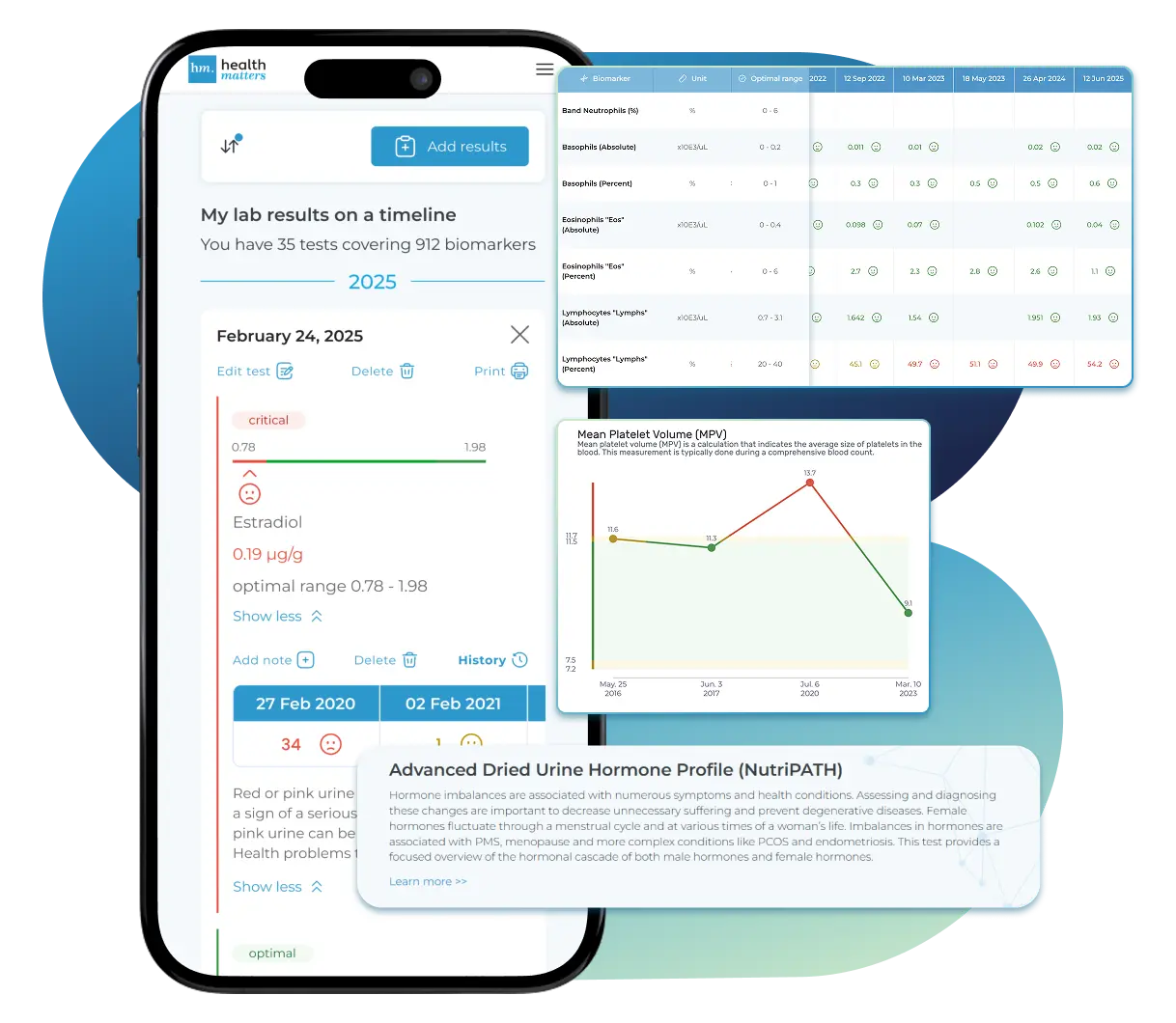Citrate is a key organic acid and an essential intermediate in the citric acid (Krebs) cycle, the core metabolic pathway responsible for producing energy (ATP) within the mitochondria. On the Neurotransmitter XL panel, citrate is used as a functional marker of mitochondrial health and oxidative metabolism, reflecting how efficiently the body converts nutrients into usable cellular energy.
Because mitochondrial energy generation directly supports neurotransmitter synthesis, stress resilience, and detoxification, citrate levels can provide crucial insight into whether energy metabolism is functioning optimally—or if it’s being impaired by oxidative stress, inflammation, or nutrient deficiencies.
Citrate forms when acetyl-CoA (derived from carbohydrates, fats, or proteins) combines with oxaloacetate at the beginning of the Krebs cycle. Through successive enzymatic steps, citrate is oxidized to generate NADH and FADH2, which fuel ATP synthesis in the mitochondrial electron transport chain.
In short, citrate acts as the gateway to cellular energy production—and its balance determines whether mitochondria are operating efficiently or under stress.
Citrate does more than produce ATP. It plays a role in multiple biochemical processes:
Energy Regulation: Reflects mitochondrial performance and cellular respiration efficiency.
Neurotransmitter Function: Supplies acetyl groups for acetylcholine synthesis and supports ATP-dependent neurotransmitter metabolism.
Fatty Acid and Cholesterol Synthesis: Acts as a precursor for acetyl-CoA in cytosolic lipid metabolism.
Acid-Base Balance: Citrate can bind to minerals (like calcium and magnesium) and buffer blood pH, aiding systemic stability.
Detoxification: Supports the generation of energy required for hepatic conjugation and toxin removal.
Because neurotransmitter formation, breakdown, and recycling are all ATP-dependent, citrate levels serve as an indirect marker of how well the nervous system is supplied with the energy it needs to function.
Under conditions of chronic stress, oxidative stress, or mitochondrial dysfunction, the citric acid cycle becomes disrupted. This can lead to abnormal accumulation—or depletion—of intermediates like citrate, pyruvate, and lactate.
Evaluating citrate alongside related organic acids helps pinpoint where energy metabolism is breaking down:
Elevated lactate and pyruvate with high citrate can indicate blocked mitochondrial entry or oxidative inhibition.
Low citrate suggests poor substrate flow into the Krebs cycle or nutrient deficiencies (e.g., magnesium, B vitamins, L-carnitine).
High citrate with elevated citrulline may suggest nitrosative stress, as nitric oxide disrupts mitochondrial aconitase function.
In this way, citrate acts as a window into both mitochondrial resilience and neuroenergetic balance—core components of stress and mental health physiology.
Mitochondria rely on optimal oxygen delivery, nutrient cofactors, and an intact electron transport chain. When any of these are impaired, citrate accumulates or becomes dysregulated, reflecting reduced conversion into subsequent Krebs intermediates (like a-ketoglutarate or succinate).
Excess reactive oxygen species (ROS) or nitric oxide (NO) can inhibit aconitase, the enzyme that converts citrate to isocitrate. This leads to citrate buildup and signals mitochondrial stress. Chronic inflammation, infections, or toxic exposures often trigger this state.
The Krebs cycle depends on several key nutrients:
Magnesium and manganese (enzyme activation)
B vitamins (B1, B2, B3, B5) (coenzyme formation for NAD+, FAD, and CoA)
L-carnitine and CoQ10 (for fatty acid oxidation and electron transport)
Deficiency in any of these can slow citrate metabolism, leading to low ATP and high fatigue.
Imbalanced carbohydrate or fat intake, prolonged fasting, or insulin resistance can disrupt acetyl-CoA flow into the citric acid cycle, altering citrate levels.
Chronic activation of the stress axis diverts metabolic resources toward survival pathways, suppressing mitochondrial efficiency. Over time, this can reduce citrate turnover, contributing to energy exhaustion, burnout, and neurotransmitter depletion.
Low citrate levels typically reflect impaired mitochondrial function, poor nutrient availability, or inadequate energy production. When citrate is low, it suggests that acetyl-CoA entry into the Krebs cycle is limited, or that mitochondrial enzymes are underperforming due to oxidative damage or nutrient deficiency.
A low citrate level may also indicate:
Magnesium or B-vitamin deficiency (cofactors for key dehydrogenase enzymes)
Low L-carnitine or CoQ10, impairing fatty acid oxidation
Chronic fatigue or post-stress exhaustion
Reduced ATP synthesis and downstream neurotransmitter imbalance
Mitochondrial inefficiency from oxidative or nitrosative stress
Clinically, low citrate often correlates with fatigue, cognitive dullness, low motivation, and signs of metabolic slowdown.
| Related Marker | Interpretation Insight |
|---|---|
| Lactate / Pyruvate | Elevated levels with low citrate indicate blocked mitochondrial entry or anaerobic metabolism. |
| Citrulline | Elevated alongside citrate suggests nitrosative stress impairing mitochondrial aconitase. |
| NAD+ / Vitamin B3 Status | Low NAD+ reduces oxidative metabolism, contributing to low citrate. |
| SAM/SAH Ratio | A low ratio may impair methylation and ATP synthesis, compounding energy deficits. |
| Neopterin | High levels reflect immune activation and inflammatory interference with mitochondrial enzymes. |
| Carnitine and Fatty Acid Markers | Deficiency limits substrate entry into the citric acid cycle, reducing citrate. |
Together, these markers help determine whether low citrate results from nutrient deficiency, oxidative stress, or energy metabolism disruption.
Neurological and Cognitive Signs:
Chronic fatigue or "wired but tired" energy
Brain fog and poor focus
Low motivation or mental burnout
Reduced stress tolerance or irritability
Metabolic and Systemic Signs:
Cold extremities or low metabolic rate
Poor exercise tolerance
Hormonal imbalances (due to low energy for synthesis and detoxification)
Digestive sluggishness or poor nutrient absorption
When citrate levels are low, both neuronal energy production and neurotransmitter balance are affected, often manifesting as cognitive and emotional instability.
Restore cofactor sufficiency for Krebs cycle function:
B Vitamins (B1, B2, B3, B5) – essential for NAD+ and FAD production
Magnesium and manganese – enzyme activators for citrate metabolism
CoQ10, L-carnitine, alpha-lipoic acid – enhance fatty acid transport and electron transfer
NAD+ precursors (niacinamide or NMN) – support oxidative metabolism
Counter mitochondrial inhibition by replenishing antioxidant defenses:
Vitamin C, E, and glutathione for ROS control
NAC and alpha-lipoic acid to restore redox balance
Omega-3 fatty acids (DHA/EPA) for membrane stability and reduced inflammation
Balance carbohydrate and protein intake to stabilize acetyl-CoA availability
Include healthy fats (avocado, olive oil, fish) to sustain steady energy release
Avoid excessive fasting or restrictive diets that suppress mitochondrial function
Mitochondria need oxygen to produce ATP efficiently. Regular aerobic exercise and breathwork can enhance oxygen utilization and citrate cycle performance.
Long-term stress impairs mitochondrial efficiency. Integrating relaxation practices, adequate sleep, and mindfulness helps restore optimal energy metabolism.
Citrate is a vital marker of mitochondrial energy metabolism and reflects how effectively your body converts nutrients into ATP. Low levels indicate reduced Krebs cycle activity, cofactor deficiencies, or oxidative stress–related mitochondrial inhibition—conditions often linked to fatigue, cognitive decline, and poor stress recovery.
On the Neurotransmitter XL panel, citrate provides a metabolic snapshot of how stress, nutrient balance, and mitochondrial health intersect.

Import lab results from multiple providers, track changes over time, customize your reference ranges, and get clear explanations for each result. Everything is stored securely, exportable in one organized file, and shareable with your doctor—or anyone you choose.
Cancel or upgrade anytime

Low citrate levels on the Neurotransmitter XL panel indicate reduced mitochondrial energy production and impaired function of the citric acid (Krebs) cycle—the body’s central pathway for generating ATP from carbohydrates, fats, and proteins. Citrate is the first major intermediate in this cycle and a critical link between cellular metabolism, neurotransmitter activity, and detoxification capacity.
When citrate levels are low, it often reflects poor substrate utilization, cofactor deficiency, or oxidative stress interfering with the enzymes that drive mitochondrial energy conversion. This can result in low ATP production, fatigue, reduced stress resilience, and impaired neurotransmitter synthesis.
Citrate forms when acetyl-CoA (from glucose, fatty acids, or amino acids) combines with oxaloacetate inside the mitochondria. This reaction, catalyzed by citrate synthase, marks the entry point of carbon fuel into the Krebs cycle. From there, citrate should be progressively converted into isocitrate and other intermediates to generate NADH and FADH2, which power ATP formation.
Low citrate means that:
The Krebs cycle is underactive or “stalled”, often due to mitochondrial stress.
There’s limited acetyl-CoA supply (from poor nutrient intake or metabolism).
Key enzyme cofactors (B vitamins, magnesium, manganese) are lacking.
Oxidative or nitrosative stress is inhibiting mitochondrial enzymes such as aconitase, which converts citrate into isocitrate.
Because neurotransmitter synthesis (especially dopamine, serotonin, and acetylcholine) depends heavily on ATP availability, low citrate can disrupt brain chemistry and energy balance simultaneously.
Low citrate often reflects impaired mitochondrial performance, where the Krebs cycle slows due to oxidative stress, inflammation, or insufficient oxygen delivery. This leads to lower ATP output and compensatory shifts toward anaerobic metabolism (increased lactate and pyruvate).
The Krebs cycle relies on a steady supply of key nutrients, including:
B vitamins (B1, B2, B3, B5): Essential for NAD+, FAD, and coenzyme A production.
Magnesium and manganese: Required for enzyme activation in multiple Krebs steps.
L-carnitine and CoQ10: Transport fatty acids into mitochondria and facilitate electron transport.
Deficiency in any of these nutrients can limit the formation or utilization of citrate.
Reactive oxygen species (ROS) and nitric oxide (NO) can inhibit aconitase, the enzyme responsible for converting citrate to isocitrate. This not only lowers citrate turnover but also signals nitrosative mitochondrial stress—a common feature in chronic fatigue, inflammation, or neurodegenerative patterns.
When the body cannot efficiently metabolize macronutrients into acetyl-CoA—due to low glucose oxidation, carnitine deficiency, or fatty acid oxidation issues—less citrate is produced. Low-protein diets, fasting, or malabsorption can also reduce substrate input into the Krebs cycle.
Prolonged activation of the stress axis (HPA axis) increases cortisol output, alters mitochondrial dynamics, and redirects energy resources away from cellular metabolism. Over time, this depletes ATP production capacity, leading to lower citrate levels.
Citrate is an early marker of mitochondrial ATP generation. Low levels indicate that cells are not producing enough energy to meet physiological demands, resulting in fatigue, weakness, and poor recovery from stress or exercise.
Energy-demanding processes such as dopamine synthesis, serotonin conversion, and acetylcholine production rely on adequate ATP. Low citrate can contribute to:
Brain fog and poor concentration
Low motivation and mood instability
Impaired stress adaptation or “burnout” feelings
Citrate supports hepatic metabolism by fueling detoxification reactions and stabilizing acid-base balance. Low levels can slow detoxification of hormones, drugs, and toxins, and impair fat metabolism, potentially contributing to fatty liver or hormonal imbalance.
Low citrate often occurs alongside elevated lactate, pyruvate, or suberic acid, suggesting a shift toward anaerobic metabolism. This pattern is common in oxidative stress, inflammation, and nutrient insufficiency.
| Related Marker | Interpretation Insight |
|---|---|
| Lactate / Pyruvate | Elevated values with low citrate indicate mitochondrial bottleneck or oxygen deficiency. |
| Citrulline | Elevated levels suggest nitrosative stress suppressing aconitase activity. |
| NAD+ / Vitamin B3 | Low NAD+ limits oxidative metabolism, compounding low citrate. |
| SAM/SAH Ratio | Low ratio suggests insufficient methylation energy, contributing to mitochondrial slowdown. |
| Neopterin | Elevated levels indicate inflammation-driven oxidative inhibition of mitochondrial enzymes. |
| Carnitine / Suberic Acid | Low carnitine impairs fatty acid transport, reducing acetyl-CoA and citrate formation. |
When analyzed together, these markers can clarify whether low citrate results from cofactor depletion, mitochondrial dysfunction, or oxidative stress–induced metabolic inhibition.
Neurological and Cognitive:
Chronic fatigue and lack of motivation
Brain fog or mental sluggishness
Depressive mood or low resilience
Sleep disruption or non-restorative rest
Systemic and Metabolic:
Cold extremities or slow metabolism
Poor exercise tolerance
Digestive sluggishness
Low stress tolerance or burnout sensations
Hormonal irregularities (due to reduced detoxification)
Because low citrate reflects a fundamental energy imbalance, symptoms often affect both mental and physical vitality.
Support mitochondrial enzyme activity by restoring key nutrients:
B vitamins (B1, B2, B3, B5) to restore NAD+ and FAD levels
Magnesium, manganese, and zinc for enzyme activation
CoQ10 and L-carnitine to enhance electron transport and fatty acid oxidation
Alpha-lipoic acid and NAC to protect against oxidative damage
Include steady complex carbohydrates and lean proteins to fuel acetyl-CoA formation.
Avoid extreme fasting, very low-carb diets, or prolonged caloric restriction.
Hydrate well and maintain stable blood glucose levels to sustain mitochondrial input.
Use antioxidants such as vitamin C, E, glutathione, and CoQ10.
Ensure adequate omega-3 intake (EPA/DHA) to stabilize membranes and reduce inflammation.
Support nitric oxide balance through arginine, citrulline, and antioxidant-rich foods.
Engage in moderate aerobic exercise to enhance oxygen utilization.
Practice deep breathing or relaxation techniques to optimize cellular oxygen delivery.
Address psychological and physiological stressors that suppress mitochondrial performance.
Prioritize restorative sleep, mindfulness, and balanced recovery periods.
Low citrate levels reflect underactive mitochondrial energy metabolism, often caused by nutrient deficiencies, oxidative stress, or chronic metabolic strain. This imbalance limits ATP production, affecting energy, cognition, and neurotransmitter function while contributing to fatigue, mood changes, and detoxification issues.
By restoring mitochondrial cofactors (B vitamins, magnesium, CoQ10, L-carnitine), supporting redox balance, and reducing chronic stress, citrate metabolism and cellular energy can be reactivated.
Laboratories
We accept reports from any lab, so you can easily collect and organize all your health information in one secure spot.











Pricing Table
Choose the plan that fits you — and turn scattered lab reports into clear insights you can finally use.
Pick a plan that fits you — and turn scattered lab reports into clarity.
Personal plans
Professional plan
$15/ month
Access your lab reports, explanations, and tracking tools.
$250/ once
Pay once, access everything—no monthly fees, no limits.
Professional plan
$45/ month
Designed for professionals managing their clients' lab reports
About membership
 Import Lab Results from Any Source
Import Lab Results from Any Source
Easily upload lab results from any provider, whether it's a hospital, independent lab, or home testing service. We support PDFs, scanned documents, and JPEGs from patient portals. No need to log in to multiple platforms — everything is centralized in one secure space.
Easily upload lab results from any provider — we support PDFs, scans, and images. Keep all your reports organized in one secure place.
 See Your Health Timeline
See Your Health Timeline
Every lab result is automatically organized on a chronological timeline, giving you a complete picture of your health journey. Whether you're tracking a condition, managing treatments, or staying proactive, the timeline helps you and your doctor understand how things progress over time.
Every lab result is automatically organized on a chronological timeline, giving you a complete picture of your health journey.
 Understand What Your Results Mean
Understand What Your Results Mean
Whether it's a blood test, GI panel, urinalysis, or something else, lab reports measure numerous biomarkers that reveal what's happening inside your body. Our extensive database covers over 10,000 biomarkers, providing clear, simple explanations of what each result means and how you can take action—no matter your membership level. Say goodbye to confusion and get the insights you need to better understand your health.
Our database covers over 10,000 biomarkers with clear, simple explanations—so you can finally understand your results and what to do next.
 Enter Your Lab Reports Yourself — Always Free
Enter Your Lab Reports — Always Free
Enter Your Lab Reports Yourself — Always Free
Enter Your Lab Reports — Always Free
If you'd like to handle inputting your health data into your account, you can do so with our easy-to-use data entry forms. Our user-friendly form is designed to guide you through the quick and easy submission process, making it simple to keep track of your health metrics. This is available to both Complete plan and Unlimited plan members.
Our user-friendly form guides you through a quick, simple submission process, making it easy to enter your health metrics.
Add your results anytime with our easy entry form. It's quick, guided, and helps you stay organized — free for all members.
 Visualize Your Results
Visualize Your Results
View your lab data through easy-to-read graphs and tables. Quickly spot patterns, track changes, and compare results across different dates — all without digging through multiple reports. You can also select and compare graphs of specific biomarkers side-by-side to better understand how they relate and change over time.
See your lab reports in clear graphs and tables. Spot patterns, track changes, and compare results over time — all in one place.
 Export Your Complete Lab History in a Single File
Export Your Complete Lab History
Export Your Complete Lab History in a Single File
Export Your Complete Lab History
After collecting lab results from different providers, you can download your entire history combined into a single file. Choose from PDF, Excel, or CSV formats to easily review, share, or get a second opinion—no more juggling multiple reports.
After collecting lab results from different providers, you can download your entire history combined into a single file.
 Comprehensive Data Entry Service for Your Reports
Data Entry Service for Your Reports
Comprehensive Data Entry Service for Your Reports
Data Entry Service for Your Reports
Our inclusive service handles the data entry for your lab reports. Just submit your information and we'll take care of the rest. Complete plan members receive one report entered for free, then $15 per report after that. Unlimited plan members receive ten report entries for free, then $15 per report after that.
Our inclusive service handles the data entry for your lab reports. Just submit your information and we'll take care of the rest.
 Securely Share With Anyone You Trust
Securely Share With Anyone You Trust
Whether you're working with a doctor, nutritionist, caregiver, or wellness coach, you can securely share your complete lab history by sending an invite link to anyone you trust. You have full control over who sees your information and for how long, ensuring your privacy and peace of mind at every step.
Share your full lab history with your doctor, nutritionist, or coach using a secure invite link.
Discover






I have been using Healthmatters.io since 2021. I travel all over the world and use different doctors and health facilities. This site has allowed me to consolidate all my various test results over 14 years in one place. And every doctor that I show this to has been impressed. Because with any health professional I talk to, I can pull up historical results in seconds. It is invaluable. Even going back to the same doctor, they usually do not have the historical results from their facility in a graph format. That has been very helpful.
Anthony
Unlimited Plan Member since 2021

What fantastic service and great, easy-to-follow layouts! I love your website; it makes it so helpful to see patterns in my health data. It's truly a pleasure to use. I only wish the NHS was as organized and quick as Healthmatters.io. You've set a new standard for health tracking!
Karin
Advanced Plan Member since 2020

As a PRO member and medical practitioner, Healthmatters.io has been an invaluable tool for tracking my clients' data. The layout is intuitive, making it easy to monitor trends and spot patterns over time. The ability to customize reports and charts helps me present information clearly to my clients, improving communication and outcomes. It's streamlined my workflow, saving me time and providing insights at a glance. Highly recommended for any practitioner looking for a comprehensive and user-friendly solution to track patient labs!
Paul
Healthmatters Pro Member since 2024
Healthmatters is a personal health dashboard that helps you organize and understand your lab results. It collects and displays your medical test data from any lab in one secure, easy-to-use platform.
With a Healthmatters account, you can:
Professionals can also analyze client data more efficiently and save time managing lab reports.
Healthmatters.io personal account provides in-depth research on 4000+ biomarkers, including information and suggestions for test panels such as, but not limited to:
You can combine all test reports inside your Healthmatters account and keep them in one place. It gives you an excellent overview of all your health data. Once you retest, you can add new results and compare them.
If you are still determining whether Healthmatters support your lab results, the rule is that if you can test it, you can upload it to Healthmatters.
While we work with many popular labs, we welcome reports from lots of other places too.
It's as simple as this: if you can get a test done, you can upload it to Healthmatters and we can interpret results from any lab out there. If laboratories can analyze it, we can interpret it.
If you're on the hunt for a specific biomarker, contact us and we'll add it to our database. Anything from blood, urine, saliva, or stool can be uploaded, understood, and tracked with your Healthmatters account.
The Complete Plan ($15/month) is perfect for individuals who want ongoing access to their health data. It includes unlimited lab imports, visual tracking, custom ranges, result explanations, full account exports, and secure sharing — all with a simple monthly subscription. You can cancel anytime and restart your plan whenever you're ready — your data will still be there waiting for you. You can also upgrade to the Unlimited Plan at any time, with the cost prorated based on what you've already paid.
The Unlimited Plan ($250 one-time) is also designed for individuals but offers lifetime access with no ongoing subscription. You'll get all the same features as the Complete Plan, plus a larger initial data entry allowance (10 reports), making it a great choice if you prefer a one-time payment and long-term use without monthly fees.
In short:
There are two ways to add your test reports to your Healthmatters account. One option is to input the data using the data entry forms. The other method is to utilize our "Data entry service."
Our data entry forms offer an easy, fast, and free way for you to input the reports yourself. Self-entry allows you to add an unlimited number of reports at no cost. We make the self-entry process user-friendly, providing dozens of templates that pre-populate the most popular laboratory panels and offering instant feedback on entered values.
For those who prefer assistance, we offer a "Data entry service" to help you input your data. Simply attach an image or file of your lab test results, and a qualified team member from our data entry team will add the results for you.
We support various file types, including PDFs, JPGs, or Excel. This service is particularly useful if you have many reports to upload or if you're too busy to handle the data entry yourself.
Our Data Entry Service is for when you don't want to manually type in your lab results yourself. You simply upload your report (PDF, image, or screenshot), and our trained team enters the information into your Healthmatters account for you — accurately and neatly organized, ready to view in graphs, tables, and timelines.
The $15 per report covers the time and care it takes for a real person to review your file, make sure each result is entered correctly, and double-check for accuracy. This ensures your health data is precise and easy to work with — without you having to spend the time doing it yourself.
Prefer to do it yourself? You can always use our free self-entry tool to add results manually — it just takes a bit more time and attention.
For users on the Complete monthly plan, the first report is entered free of charge, and each additional report incurs a fee of $15.
Unlimited account holders enjoy the entry of ten reports without charge. Subsequent reports are subject to a $15 fee per report.
Additionally, users on the Complete plan can upgrade to a yearly subscription from the account settings. The annual subscription includes a data entry service for five reports.
All professional accounts allow you to import and onboard an unlimited number of clients and their lab results. The distinction between professional plans lies solely in the data entry service.
The Pro Monthly Plus plan is priced at $75 per month and includes a data entry service for five reports each month. Additional reports can be self-entered at no extra cost or, if preferred, you can use our data entry service for an additional fee of $15 per report.
The Pro Monthly plan is priced at $45 per month and does not include a data entry service. Self-entry is free for an unlimited number of reports, and you can opt for the data entry service at a fee of $15 per report.
You also have the option to upgrade to higher monthly or to annual plans, which come with substantial discounts. All upgrades can be done directly from your account.
Simply log in and navigate to your account settings to cancel your subscription. Scroll down to locate the 'Cancel' button at the bottom of the page. Ensure you cancel at least one day before the renewal date to prevent any charges. Once cancellation is requested, the subscription remains active until the conclusion of the current billing cycle.
Our goal has been to make your Healthmatters account as intuitive as possible.
We've crafted multiple ways for you to navigate your data, whether you're glancing at a single report or delving into your historical test reports.
1. Graph View:Dive into a visual journey with our biomarker graphs, showcasing over 40 data points. Combining years of results unveils trends, empowering you to make informed decisions. Our visualization tools make it a breeze to compare and understand changes over time, even if your results are from different labs. A search function and filters simplify the exploration of extensive data, allowing you to focus on what needs attention.
2. All Tests ViewExplore neatly organized reports on a timeline, highlighting crucial details like dates, critical results, and lab/panel names. Each report opens up to reveal in-depth descriptions and additional recommendations for each biomarker. The history of previous results is just a click away, and you can download a comprehensive report for deeper insights. Color-coded and user-friendly, it's designed for easy reading, understanding, and navigation.
3. Table View:For a holistic view of all biomarkers side by side, our table view is your go-to. Results are neatly displayed in a categorized and dated table, ideal for those with an extensive test history. Utilize sorting, filters, and color-coding to enhance your analysis and gain extra insights.
Yes, you can download your information anytime. We offer two easy ways to export your lab data:
This makes it simple to save, back up, or share your health data whenever you need.
Yes, you can print your report. To do so, navigate to "All tests" and open the report you wish to print. You'll find a print button in the right corner of the report. Click on it, and your browser's print window will open. If you prefer to print in a bigger typeface, adjust the scale using the print window settings.
Yes, you can! We highly recommend activating Two-Factor Authentication (2FA) for your account. To do so, please navigate to the "Profile and Security" section of your account, where you will find instructions for activating 2FA.
Yes, you can. When entering values for the biomarker, you will see an "Edit Range" button. Click this button, and you'll have the option to enter a custom range.
A personal account is all about keeping your own lab test results in check. It's just for you and your personal use.
The professional account is designed for health professionals who wish to track and organize their clients' laboratory results.
To learn more about Healthmatters Pro, please refer to the professional page.
At HealthMatters, we're committed to maintaining the security and confidentiality of your personal information. We've put industry-leading security standards in place to help protect against the loss, misuse, or alteration of the information under our control. We use procedural, physical, and electronic security methods designed to prevent unauthorized people from getting access to this information. Our internal code of conduct adds additional privacy protection. All data is backed up multiple times a day and encrypted using SSL certificates. See our Privacy Policy for more details.

